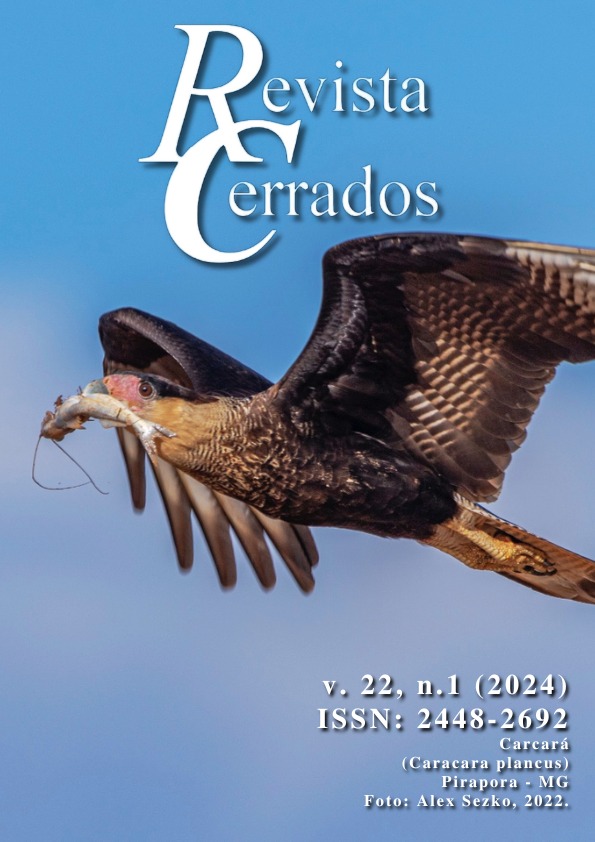Landscape and anthropic action in Santa Fé do Araguaia/TO: subsidies for environmental conservation
DOI:
10.46551/rc24482692202404Keywords:
Vegetal cover, Land use, Geotechnologies, TocantinsAbstract
The expansion of agriculture together with the urbanization process are factors that can contribute to the reduction of native forests in several regions of Brazil. Thus, the objective of this work was to analyze the degree of anthropic alteration of the landscape in the municipality of Santa Fé do Araguaia/Tocantins, from 2009 to 2019. To this end, a bibliographic survey was carried out in official consultation bases: Scielo and Portal de Periódico Capes on changes in the landscape, in addition to obtaining cartographic bases free of charge on the website of the National Institute for Space Research, at a scale of 1:100,000. These were cut out according to the delimitation of the study area, using the free software QGis, version 3.18 and Spring version 5.4.3. The data analyzed show a reduction in vegetation caused mainly by extensive livestock farming, which currently occupies 75,65% of the municipality analyzed. The forested Savanna vegetation types and the Ecological Tension Area with contact between Savanna and Ombrophylous Forest had their areas reduced to 0%, while the Submontane Open Ombrophylous Forest had a reduction of 12,14%. Given the results, it is clear to highlight the concern about the advancement of deforestation, since forests provide important functions for the balance of ecosystems.
Downloads
References
BARROS, E. N. S.; VIOLA, M. R.; RODRIGUES, J. A. M.; MELLO, C. R.; AVANZI, J. C.; GIONGO, M. Modelagem da erosão hídrica nas bacias hidrográficas dos rios Lontra e Manoel Alves Pequeno, Tocantins. Revista Brasileira de Ciências Agrárias, Recife, [S./l.], v. 13, n. 1, p. 1-9, 2018.
BBC NEWS BRASIL. Brasil, Bolívia e Peru estão entre campeões mundiais de desmatamento. 2022. Disponível em: https://www.bbc.com/portuguese/internacional-59300251. Acesso em: 28 abr. 2022.
BRASIL. Portal da Transparência do Governo Federal. Benefício ao cidadão. 2020. Disponível em: http://www.portaltransparencia.gov.br/beneficios?ano=2020. Acesso em: 01 abr. 2021.
BUSTAMANTE, M. M. C.; SCARIOT, A.; BAGER, A. TURRA, A.; BARBIERI, A.; NEVES, A.; BOESING, A. L.; AGOSTINHO, A.; DIAS, B.; GRELLE, C. E.; CAIXETA, D.; SAWYER, D. et al. Tendências e impactos de degradação e restauração da biodiversidade e serviços ecossistêmicos. 2019. Disponível em: https://www.alice.cnptia.embrapa.br/alice/bitstream/doc/1112421/1/Tendenciaseimpactosdosvetoresdedegradacao2019.pdf. Acesso em: 27 jan. 2024.
CÂMARA, G.; SOUZA, R. C. M.; FREITAS, U. M.; GARRIDO, J. SPRING: Integrating remote sensing and GIS by object-oriented data modeling. Computers & Graphics, [S./l.], v. 20, n. 3, p. 395-403, 1996.
CAPORAL, F. R.; COSTABEBER, J. A. Agroecologia: alguns princípios. Brasília: MDA/SAF/DATER, 2004. 24p.
CARVALHO, G. Histórico e impacto das políticas públicas na Amazônia. In: BARROS, A. C. (Org.). Sustentabilidade e Democracia para as políticas públicas na Amazônia. Rio de Janeiro: Projeto Brasil Sustentável e Democrático. FASE/IPAM, 2001. p. 13-24.
CAVALCANTI, L. C. S. Cartografia de paisagens: fundamentos. 2. ed. São Paulo: Oficina de Textos, 2018, 96p.
FLORENZANO, T. G. Iniciação em Sensoriamento Remoto. 3. ed. São Paulo: Oficina de Textos, 2011. 128p.
IBGE. Instituto Brasileiro de Geografia e Estatística. Manual Técnico da Vegetação Brasileira. Rio de Janeiro: IBGE, 2012, 323p.
IBGE. Instituto Brasileiro de Geografia e Estatística. Potencial de agressividade climática na Amazônia Legal. 2014. Disponível em: https://biblioteca.ibge.gov.br/visualizacao/livros/liv95900.pdf. Acesso em: 01 abr. 2021.
IBGE. Instituto Brasileiro de Geografia e Estatística. Pesquisa da pecuária municipal de Santa Fé do Araguaia/TO. 2019. Disponível em: https://sidra.ibge.gov.br/tabela/3939#resultado. Acesso em: 01 de abr. 2021.
IBGE. Instituto Brasileiro de Geografia e Estatística. Panorama do município de Santa Fé do Araguaia/TO. 2020. Disponível em: https://cidades.ibge.gov.br/brasil/to/santa-fe-do-araguaia/panorama. Acesso em: 14 mar. 2021.
INPE. Instituto Nacional de Pesquisas Espaciais. SPRING: Tutorial de Geoprocessamento. 2006. Online. Disponível em: http://www.dpi.inpe.br/spring/ portugues/tutorial/index.html. Acesso em: 30 jan. 2024.
JACOBI, P. R.; BESEN, G. R. Gestão de resíduos sólidos em São Paulo: desafios da sustentabilidade. Estudos Avançados, São Paulo, v. 25, n. 71, p. 135-158, 2011.
LEMES, G. S.; SILVA, J. P. Perspectivas do uso de sistemas agroflorestais em áreas de reforma agrária no município de Conceição do Araguaia-PA. 2017. 80 f. Monografia (Tecnologia em Gestão Ambiental) - Instituto Federal de Educação Ciência e Tecnologia do Pará, Conceição do Araguaia-PA, 2017.
LOPES, A. P. Escravidão por dívida no Tocantins-Brasil: vidas dilaceradas. Curitiba: Appris, 2018.
LIMA, A. A. C.; OLIVEIRA, F. N. S.; AQUINO, A. R. L. Solos e Aptidão Agrícola das terras do estado do Tocantins. Fortaleza: Embrapa Agroindústria Tropical, 2000. 27 p.
MAGALHÃES, R. J.; BARBOSA JÚNIOR, A. R. O valor do serviço de proteção de mananciais. Eng. Sanit. Ambient., Rio Claro, v. 24, n. 5, p. 1049–1060, 2019.
MAZOYER, M.; ROUDART, L. História das agriculturas no mundo: do neolítico à crise contemporânea. Tradução: Cláudia F. Falluh Balduíno Ferreira. São Paulo: UNESP/NEAD, 2010. 568p.
MOUTINHO, P.; AZEVEDO-RAMOS, C. Empobrecimento da floresta amazônica: desmatamento, exploração e madeireira e fogo. In: BARROS, A. C. (Org). Sustentabilidade e Democracia para as políticas públicas na Amazônia. Rio de Janeiro: Projeto Brasil Sustentável e Democrático. FASE/IPAM, 2001. p. 25-40.
PNUD. Programa das Nações Unidas para o desenvolvimento. IDHM municípios 2010. Disponível em: https://www.br.undp.org/content/brazil/pt/home/idh0/rankings/idhm-municipios-2010.html. Acesso em: 30 abr. 2022.
QGIS. Geographic Information System API Documentation. QGIS Association, 2021.
RIVERO, S.; ALMEIDA, O.; ÁVILA, S.; OLIVEIRA, W. Pecuária e desmatamento: uma análise das principais causas diretas do desmatamento na Amazônia. Nova Economia, Belo Horizonte, v. 19, n. 1, p.41-66, 2009.
SANTA FÉ DO ARAGUAIA. Prefeitura municipal de. História. 2023. Disponível em: https://www.santafedoaraguaia.to.gov.br/municipio#municipio-historia. Acesso em: 30 jan. 2024.
SANTOS, D. A. R.; MORAIS, F. Assimetria de bacias hidrográficas e influências litoestruturais na geomorfologia do rio Formoso, TO. Caminhos da Geografia, Uberlândia, v. 18, n. 61, p. 180-199, 2017.
SCOTT, C. E.; MONKS, S. A.; SPRACKLEN, D. V. et al. Impact on short-lived climate forcers increases projected warming due to deforestation. Nature Communications, [S./l.], 9, 157, p. 1-9, 2018.
SEPLAN/TO. Secretaria da Fazenda e Planejamento do Estado do Tocantins. Inventário Florestal e levantamento florístico – norte do estado do Tocantins. 2005. Disponível em: http://zoneamento.sefaz.to.gov.br/Publicacoes_Tecnicas/Norte_Tocantins/Relatorios_Tecnicos_Norte/Inventario%20florestal/Relatorio_InvFlorestal_Norte_TO.pdf. Acesso em: 10 jun. 2021.
SEPLAN/TO. Secretaria da Fazenda e Planejamento do Estado do Tocantins. Perfil Socioeconômico dos Municípios. 2017. Disponível em: http://www.sefaz.to.gov.br/estatistica/estatistica/perfil-socioeconomico-dos-municipios/. Acesso em: 15 mar. 2021.
TUNDISI, J. G.; TUNDISI, T. M. Impactos potenciais das alterações no código florestal nos recursos hídricos. Biota Neotrop., Campinas, v. 10, n. 4, p. 67-75, 2010.
VIEIRA FILHO, J.; Eustáquio R. Expansão da fronteira agrícola no Brasil: desafios e perspectivas. Brasília: Rio de Janeiro/IPEA, 2016. 36p.
ZEN, S.; BARIONI, L.; BONATO, D. B. B.; ALMEIDA, M. H. S.; RITTL, T. F. Pecuária de corte brasileira: impactos ambientais e emissões de gases efeito estufa. 2008. Disponível em: https://www.cepea.esalq.usp.br/br /documentos/texto/pecuaria-de-corte-brasileira-impactos-ambientais-e-emissoes-de-gases-efeito-estufa-gee.aspx. Acesso em: 02 jul. 2021.
Downloads
Published
How to Cite
Issue
Section
License
Copyright (c) 2024 Revista Cerrados

This work is licensed under a Creative Commons Attribution-NonCommercial-NoDerivatives 4.0 International License.
In this journal, the copyrights for published articles belong to the author (s), with the rights of the first publication belonging to Revista Cerrados. The articles are publicly accessible, free to use, their own assignments, educational assignments and non-commercial applications.


















